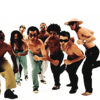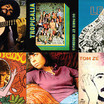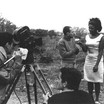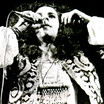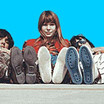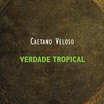Eubioticamente atraídos

tropicália: avant-garde
Foreign views
TROPICÁLIA
Avant-garde, Popular Culture, and the Culture Industry in Brazil (1967-1972)
Carlos Basualdo
[…] how to explain, in an underdeveloped country, the appearance of an avant-garde and justify it not as symptomatic alienation, but as a decisive factor in collective progress?
Hélio Oiticica, “General Scheme of a New Objectivity”
With an empty stomach
I am unable to sleep
And with my belly full I began to think
That by organizing myself I can disorganize
That by disorganizing I can get organized
Chico Science, “From Mud to Chaos”
1. Why not?
Although picturesque, the photos of the period don’t tell us much. In the fifth edition of Balanço da bossa, the celebrated book about popular music by the Concrete poet Augusto de Campos, there are two photos of Caetano Veloso, looking astonishingly youthful as he performs “Alegria, Alegria” [Joy, joy] on the stage of the Paramount Theater in October 1967 at the third Festival of Brazilian Popular Music organized by tv Record in the city of São Paulo. The photos are not eloquent: Veloso, wearing a sport coat and turtleneck, and with a head of curly hair, extends his left arm with the intention of presenting one of his musicians, who stands nearby and bows his head – the long hair covering half of his face – accepting the audience’s applause while firmly grasping his electric guitar. To the right of the charismatic Bahian musician a smiling announcer in a formal tuxedo applauds next to an excessively made-up woman wearing a long dress. The photo tells us nothing about the scandal that unfolded when the press reported that Veloso would perform his song accompanied by a group of Argentine pop musicians – The Beat Boys – with their electric guitars. To give an idea of the intense climate of debate that surrounded Veloso’s decision, it is worth mentioning that just days before the festival he had felt it necessary to make a declaration to the journalist, poet, and lyricist Torquato Neto, who published it in his column in the Jornal dos Sports on September 27:
It’s foolish to insist on making samba a dead music for museums. Samba hasn’t died: it’s thriving. And this is what interests me…the electric guitar is a beautiful instrument. As long as it exists it will be used in samba. I grew up listening to the trio elétricos of Bahia that still animate the carnival there; and nobody ever thought to say that the trios elétricos play iê-iê-iê.” 1
Neither the black and white photos nor the recorded images that preserve the event succeed in fully transmitting the climate of that moment. Only a year earlier, Caetano dressed in a dark suit and tie, as was the norm among the participants of the second tv Record festival, could have been seen smiling from the wings of the stage upon hearing the news that he had been voted Best Lyricist. Now, one year later, Caetano was standing on the stage, dressed in a tweed jacket and orange turtleneck, singing a marcha with psychedelic lyrics to the sound of electric guitars. Leaving the stage smiling, cheered by an audience from which he was only expecting jeers, he had no way of knowing that with this symbolic gesture he had initiated one of the most violent and profound transformations of recent history, not only in popular music, but in Brazilian culture generally.
The use of electric guitars in a popular music festival became such a delicate and contentious issue due to the position popular music occupied in Brazil at the end of the 1960s. In the period that begins with the military coup in 1964 – and to some extent ends in 1968 with the promulgation of the Fifth Institutional Act that officially sanctioned state repression and censorship – popular music had become the privileged vehicle for the expression of political dissent. In the cultural imaginary of the period, the role of popular music was to articulate a national ideal, conceived in terms of revalorizing cultural “roots,” and to exercise freedom of expression in open opposition to the ideological and political project of the military government. For an important group of popular musicians who were strongly influenced by the ideology associated with the Peoples’ Centers for Culture (cpc), this meant expressing a clear message of protest, with revolutionary connotations, while staying faithful on a formal level to the tradition of popular music. In other words, the idea was to articulate a project of national identity, which the most orthodox left-wing thinkers found germinating in popular expressions.
For Veloso – as for Glauber Rocha, Hélio Oiticica, and José Celso Martinez Corrêa – this position only succeeded in rendering the cultural materials with which they worked folkloric, thereby inhibiting the possibility of elaborating an effective and mobilizing critical stance on contemporary Brazilian culture and its place in the international context. This space of reflection could only be created through an act of violence, through the genesis of a “critical attempt to create Brazilian culture through the use of all expressive tendencies of this culture” as José Carlos Capinan and Torquato Neto wrote, half in jest but also seriously, in the script for the television program “Life, Passion, and Banana of Tropicalism,” which never aired. 2
This project – which amounts to the formulation of an avant-garde movement in Brazil – had been laid out six months earlier by Hélio Oiticica in his essay “General Scheme for a New Objectivity,” which opened the catalogue of the show “New Brazilian Objectivity” at the Museum of Modern Art in Rio de Janeiro (an exhibition organized by Oiticica in collaboration with such critics and artists as Frederico Morais and Hans Haudenchild), and simultaneously by José Celso Martinez Corrêa in his “Oficina Manifesto,” which presented the work of his theater group on the occasion of the opening of “The Candle King,” a play written by Oswald de Andrade, on September 29, 1967. As Oiticica would write on this occasion: “The avant-garde phenomenon in Brazil is no longer an issue for an isolated elite group, but, rather, a broad cultural issue with great repercussions in need of collective solutions.” 3 In the words of Martinez Corrêa, “In order to express a new and complex reality it was necessary to reinvent forms that captured this new reality.” 4 This reality was that of a country in the process of development, a country that had a mixed-race population and a rich popular culture that combined indigenous, African, and European influences. All of this existed under a repressive government that imposed what was emerging as the standard of accelerated industrial development on a society marked by abysmal social and economic inequalities. It was an avant-garde project that, in certain instances, would seek a dialogue with the emerging culture industry so as to avoid becoming exclusive and elitist. The conduit that would permit and even stimulate this dialogue – an improbable dialogue if one takes into account the avatars of the historic European avant-garde – would be a careful and attentive reading of this same popular culture that Brazilian popular music claimed to defend. When Caetano Veloso was forced to defend the use of strategies coming from rock ‘n’ roll as a means for updating and strengthening musical production in Brazil, he found no better argument than to point out the use of these strategies in popular culture. Electric guitars, he noted in response to the zealous guardians of musical tradition, have always been used by the trios elétricos of the Bahian carnival. In other words, there is nothing more innovative than the free use of references that popular culture puts into play on a daily basis, as a survival strategy. 5
That specific comment by Caetano – although possibly motivated by the desire to distract the attention of the reader from what appears to be both his and Gilberto Gil’s primary intention of introducing elements of rock to Brazilian popular music – serves undoubtedly to characterize the notion of popular culture that motivated both Bahian musicians. They conceived it less as the result of a process than as the process itself in its dynamic character–and therefore in its capacity to maintain this dynamism through a structural openness in relation to external influences and stimuli. For Caetano and Gil, as for Hélio Oiticica and José Celso Martinez Corrêa, popular culture was not a collection of fads and pre-established images, rather, it consisted above all in a certain mechanics of apprehension, interpretation, and reformulation of circulating information. This potential inherent to popular expressions such as carnival, Northeastern music, or street art would be the means that would ideally permit these artists to revolutionize the cultural forms with which they worked so as not to produce work that alienated or was alienated from the public at large. It is in this sense that we may understand Martinez Corrêa’s use of references to popular forms in his theater – references to the circus, the variety show, and the operetta – in his search for a “super-theatricality, the overcoming of Brechtian rationality through a theatrical art that is a synthesis of all arts and non-arts, circus, variety show, etc.” 6
For Oiticica, this meant the exploration of the architecture of the favelas (shantytowns) of Rio de Janeiro from a constructivist analytical perspective, as in his installation “Tropicália,” which he presented at the group show at the Museum of Modern Art in 1967. In the words of Oiticica, the act of entering the work should produce in the spectator the sensation “that [he or she is] . . . stepping on the ground again,” 7 just as the artist the poet and filmmaker Raymundo Amado later said. Popular culture, understood in its structural character, would become the tool that would allow these artists both to revolutionize the contents and forms of enunciation of their respective practices and to do so in a way that would be attractive to a wide audience, an audience whose members were increasingly summoned as participants in the context of these practices.
It is evident that it wasn’t merely a question of one or another musical instrument, but rather of a radically original conception of Brazilian culture, including the very notion of national identity, that accompanied equally significant changes in the attitudes of artists, musicians, and authors in the face of the social and political situation of the country. Caetano’s orange turtleneck sweater, his big smile together with his gesture of expansively opening his arms in an imaginary embrace while repeating the refrain of “Alegria, Alegria” are the equivalent of proposing a new lifestyle. The photos don’t tell us much, but the emotions that arise from seeing Caetano singing, smiling, and asking the audience composed mostly of middle-class students “Why not?” are extraordinarily moving. If it is moving to see an archival record of the event, filmed in black and white, how much more so must it have been to witness the performance itself four decades ago in the context of an increasingly repressive military dictatorship and in a country whose desire for modernity, social justice, and progress were brutally contradicted on a daily basis. In the face of this reality and before the audience that watched the festival in the auditorium and the anonymous audience that watched it on tv, Caetano offered the form of an affirmation that questions, and is open to all – a question that exceeds the very negation that it contains, thereby constituting an affirmation of experience and of the experimental.
It is perhaps necessary to consider a bit more carefully the shadings and resonances of this singular occurrence. A 25-year-old musician, talented but still little known, performs in front of an audience assumed to be hostile toward his manifest will to continue his work along “the evolutionary line of popular music in Brazil.” 8 The face of Caetano, singing at the TV Record festival, is less the face of a specific individual than the emergent expression of an era. Seeing it brings to mind The Beatles, May 1968 in France, which was still to come, struggles for civil rights in the United States, mini-skirts, Andy Warhol, the Prague Spring, student protests against the Brazilian and Argentine dictatorships, armed struggle, repression, torture, state terrorism. It’s all there, potentially contained in those gestures. “Why not” synthesizes the attempt of a group of artists, writers, and filmmakers to situate Brazilian culture in relation to the revolutionary changes of the late 1960s. It was an attempt to find Brazil’s place in that world, to return the world to Brazil and Brazil to the world – “Here is the end of the world” as Torquato Neto would proclaim in the voice of Gilberto Gil a little more than a year later. 9 After almost forty years, the implicit challenge in the refrain of “Alegria, Alegria,” so simple and complex at the same time, is still capable of resounding in the sweet voice of Caetano Veloso.
“Why not” is a question: why not use electric guitars, wear your hair long, dress in an orange turtleneck instead of a dark suit? Yet also, why not continue along the “evolutionary line” in Brazilian popular music, represented by the extraordinary work of Antonio Carlos Jobim and João Gilberto, by way of a dialogue with erudite music, rock’n’roll, the Beatles, and Anton Webern? Moreover, why not think about Brazilian national identity as an open process in permanent development; not as an endless search for origins, like the model inherited from Europe, but rather, as a permanently renewed challenge to selectively incorporate and elaborate cultural influences from wherever they may come? Why limit a priori the range of possible experiments to be realized within a given artistic form? Yet the way in which the question is formulated makes it less an interrogation and more a hidden affirmation. It doesn’t ask so much as it affirms. And what it affirms is a suspended negation. The semantic device is complex: the phrase contains a question that doesn’t express itself as such, an affirmation suspended by the interrogative tone, and a negation contradicted by the affirmative and inquisitorial character of the proposition. Above all, it is particularly interesting that it doesn’t involve the display of pure negativity nor of dogmatic affirmation. The absolutely innovative dimension of the work of Veloso, Martinez Corrêa, and Oiticica among others who compose the Tropicalist constellation is all at once in play in the structure of this phrase. It is not simply a critique of the state of things in Brazil, if by critique we mean the unfolding of a strategy based on negativity – the negation of what it is, with the goal of actualizing a possible future. Nor does it involve a mere celebration of what already exists. Neither critique in the oppositional sense, nor celebration, innocent or cynical, Tropicalism would attempt to fashion itself as a mechanism capable of incorporating – assimilating cannibalistically and therefore selectively – the complex totality of Brazilian cultural reality, with the goal of unleashing a process of radical transformation. Paraphrasing José Celso, there can only be critique where there is history and progress; in a country whose history “cannot flow,” contained by regressive political and economics conditioning – in other words, in a context in which the Hegelian notion of history is not valid – “real history will only be made with the total devouring of the structure.” 10
In Oiticica, Caetano, and José Celso, cannibalist reasoning – as articulated by the poet and essayist Oswald de Andrade in the late 1920s in his “Cannibalist Manifesto” – takes the place of Cartesianism. It is not by chance that both Oiticica and José Celso repeatedly cite Oswald in their most programmatic texts. In the words of Oiticica:
Cannibalism would be the defense that we have against foreign domination and the principal creative weapon, this constructivist will, which did not totally prevent a kind of cultural colonialism that today we want to objectively abolish, definitively absorbing it in a super-cannibalism. 11
And in an interview published in the Revista Civilização Brasileira (Brazilian Civilization Magazine) in July 1968 the Oficina director declared:
Oswald is the possibility of a critical culture, outside of official culture, lyricism, political romanticism. He is the opposite of that. He represents the cannibalistic devouring of all of the myths created to prevent this country from confronting its reality and inventing its history. 12
The Tropicalist constellation would make of Oswald de Andrade the interpretative key that would allow its members to incorporate elements of popular culture in their work within a strategy of artistic renovation articulated as an avant-garde project. The cannibalist logos – an affirmation that questions and a question that negates while affirming – lies at the center of this search.
2. Think Tropicália
Oiticica seems to have considered the creation of the terms “Tropicália” and “Supra-sensorial” important enough to register them with the National Office for Intellectual Patents; nevertheless, among the extensive and labyrinthine collection of writings, notes, letters, and jottings that constitute the ho Archive, it is difficult to find any reference to the genesis of a term that would come to be indelibly inscribed in the collective memory of Brazil. 13 Tropicália is, before all else, the title of a work constituted by the association of two Penetráveis [Penetrables], pn2 and pn3, and presented by Oiticica in the New Brazilian Objectivity show, of which he was a leading organizer.14 It was initially conceived to be a work that also incorporated the work of other artists, a sensorial labyrinth that, in the end, confronted the spectator with a television that had been left on. “The most cannibalist work of Brazilian art,” Oiticica wrote in a text dated March 4, 1968, a month after the journalist Nelson Motta had officially declared the beginning of a “Tropicalist crusade” in his February 5 column for Rio de Janeiro daily Última Hora.
Before becoming an iconic term, a monument-name, Tropicália was in the context of Oiticica’s work, “the very first conscious, objective attempt to impose an obviously ‘Brazilian’ image on the current context of the avant-garde and of national art in general.”15 Tropicália, therefore, is a strategic work. With it Oiticica sought to put to the test a series of specific images – and this in the context of a work that had been so far characterized by a high level of abstraction and structural complexity – precisely as a response to what he judged to be the panorama of international avant-garde art. In the introductory essay of the catalogue for the “New Brazilian Objectivity” show, Oiticica made a brief and precise reference to the international context, by contrasting the state of Brazilian art at the end of the 1960s, which he described in his text, with the “two main currents today: Pop and Op, and the related movements of Nouveau Réalisme and Primary Structures (Hard Edge).”16 In other words, “Tropicália” should differentiate itself from, respond to, and defy Pop art and its European derivations, the late constructivist currents, and Minimalism, while accounting for their presence and importance in the international panorama. These are the coordinates from which “Tropicália” would carry out its amazing labor of decentering. The task involved, therefore, an attempt to inflect the work with possible variations of a “Brazilian” image. “For this I created a tropical scene with plants, parrots, sand, pebbles.” 17 This scene would evoke the landscapes of the cannibalist works of the Brazilian Modernist painter Tarsila do Amaral, as noted in an unpublished draft found in the ho Archive. The landscape of “Tropicália” would be inspired on the one hand by the clichés of Brazilianness, which were both celebrated and engaged ironically, and on the other, by the experience of “walking through the hills, through the favelas” to which the artist (and dancer of the “Vê Se Me Entende” wing of the Mangueira samba school) refers so often.18 Two years before, Oiticica had attempted to “take the favela to the city,” to use an expression dear to the anthropologist Hermano Vianna, by presenting his recently created “Parangolés,” worn by a group of samba dancers from Mangueira, at the “Opinião 65” show at the Museum of Modern Art in Rio de Janeiro. At that event, the artist and the dancers were expelled from the museum19; now it was the favela itself that was firmly planted in the museum at the very center of a show partly conceived by its author and destined to constitute an explicit manifesto of the Brazilian avant-garde.
Oiticica had assiduously visited this favela since 1964 when he had been invited by the sculptor Jackson Ribeiro (who collaborated with another sculptor, Amilcar de Castro,a member of the Neo-Concrete group along with Oiticica and Lygia Clark) to work on the design of allegorical costumes for the carnival parade of the Mangueira samba school.20 Many of his friends had encouraged him to stay away from this favela as he mentions in a letter to Lygia Clark written from London on June 7, 1969: “when they told me not to go to Mangueira, I thought, I won’t say anything and go.” 21 Evidently, at the beginning of the 1960s, and perhaps more so from Oiticica’s rather romantic perspective, Mangueira represented something of a forbidden universe, a land of the marginal and marginality. In his letters to Clark, the artist makes frequent reference to marginality, defined as the sensation of finding oneself outside of class boundaries, free in relation to “the bourgeois or petit bourgeois circuit that I found myself in.” 22 It is in relation to the violence implied in such a gesture of rupture –seemingly extricating himself from the limitations of his social class in order to experience fully the world of the favelas – that we should situate Oiticica’s strategic and premeditated gesture of positioning “Tropicália” at the center of an avant-garde cultural project. In so many respects it can be seen as the equivalent of incorporating electric guitars in a festival of Brazilian popular music, but in reverse. And here the ethical dimension that Oiticica demanded from artistic production in Brazil becomes clear. “Tropicália” was the vehicle that would contaminate national cultural elitism with the substrate of a popular culture that it had always wanted to resist. For Oiticica, it was the process of “social de-conditioning” that he experienced in Mangueira that would enable him to propose a counterpoint to the international avant-garde. 23 That experience needed to be, at least in the first moment, signified by way of a series of images, to which it shouldn’t be immediately assimilated, which were capable of evoking “a subjective charge that differs greatly from European rationalism” as Oiticica writes in relation to the works of Tarsila do Amaral and Oswald de Andrade. 24 It was a work of art, but also an act of vindication, the establishment of a myth, “the myth of miscegenation – we are blacks, Indians, whites all at the same time.” 25 Anticipating the numerous and interminable polemics that Tropicalism would generate, Oiticica would add, “the myth of Tropicality is much more than parrots and banana trees: it is the consciousness of non-conditioning in relation to the established structures, therefore highly revolutionary in its totality.”26 It was a myth conceived as a counterpoint to the fetishistic mythification of the art object carried out by a dependent cultural elite, an aesthetic experience that sought to build a national identity by overcoming class barriers.
Luciano Figueiredo, an artist and the director of the Hélio Oiticica Art Center in Rio de Janeiro, has suggested that the genesis of the name Tropicália is related to that of Brasília, the then recently built national capital in the central high plains. One could say that Tropicália is the mythical double that exists in counterpoint to the real fact of Brasília. In the Brazilian social imaginary of the mid 1960s, Brasília represented a dense web of hope and contradiction that demarcated, even phonetically, the horizon of possibilities for the country. In 1964, the super-modern capital, a model city sculpturally imposed on the arid landscape of the central high plains, had ceased to be a constructive mirage brought on by the developmentalist impetus of the former president, Juscelino Kubitschek. It had been transformed into the threatening center of command for an oppressive military dictatorship. The illusion of transparency proper to modernity had suddenly become opaque in Brazil. The lyrics to the opening song of Caetano Veloso’s first solo album – coming on the heels of his great success with “Alegria, Alegria” at the TV Record festival of 1967 – would refer to this opacity in a way that was at once oblique and precise. The song was a kind of collage, between the ironic and the celebratory, that juxtaposed carnival and mulatas and the inauguration of a grotesque monument of “papier mâché and silver,” located right on the central high plains. One of Caetano’s favorites at that time, this song synthesized, in his opinion, the intentions of the record in its totality and even the entire artistic project that he had delved into programmatically just a few months before his performance at the tv Record festival. For days after it was recorded, the song remained untitled. In an informal conversation, Luis Carlos Barreto, a filmmaker connected to Cinema Novo, suggested to Veloso that he use the name of Oiticica’s work as a title for his song. Initially, Veloso didn’t seem to welcome the suggestion. “Naturally, I said no, that I wouldn’t put the name of a work by another person on my song, that this person may not like it,” the Bahian musician recalled. 27 Nevertheless, there was unanimous enthusiasm for the idea. His agent at the time, Guilherme Araújo, endorsed Barreto’s opinion, and the record producer Manuel Barenbeim wrote the name on the label of the tape recording. Brasília had been the emotional charge in Veloso’s song:
The idea of Brasília made my heart jump…Brasília, the capital-monument, the magic dream transformed into a modern experiment – and almost from the beginning, the center of the abominable power of the military dictators… Brasília, without being named, would be the center of the aberrant song-monument that I would erect to our pain, to our delight, and to our ridiculousness. 28
The same words could have come out of Oiticica’s mouth.
Without a doubt there was something in this term that seemed stangely divorced from any notion of authorship. In 1967, soon after coining the term, Oiticica worked to define and redefine it, initiating a play of signification that once begun inevitably led to the transformation of his singular work into a kind of work-monument. The same insistence with which Oiticica claimed and proclaimed that he had fathered the term to whomever would listen29 was apparent in the vehemence with which Veloso initially rejected it and in the discomfort that he still seems to have in referring to it.30 Oiticica would alternately express surprise, pride, and irritation about the diverse cultural contexts that made reference to his invention. In part, his whole work became a reaction against the fallout from the use of this term to designate a seismic change in mass culture in Brazil. And at the same time, paradoxically, he would end up making this name a true banner and calling card, appealing to its powers of suggestion while living outside of the country and confronting a cultural universe in which the logic of his own and his colleagues’ work was not easily understood. That sense of estrangement that the word Tropicália and its uses produced and still produces – not only in Veloso and Oiticica – suggests a high degree of semantic instability; the meanings initially attached to it would later become provisional and highly uncertain. Tropicália went from being the name of a work of art and a specific song to being the designation of a style, an indefinable socio-cultural movement, and a possible future. Evidently, there is something in the term itself that makes all attributions of paternity – the entire set of meanings that mean to circumscribe it – inevitably doubtful. Tropicália was meant less to designate one or another individual work than to be transformed into a catalyst for discussion and debate. This name-monument is actually less a defined visual or musical form than a collective cultural project formulated in these and other works, carried out in the brief space of the last years of the 1960s, destined to “express a new and complex reality.” 31 Once it began to circulate, aided by an emerging culture industry, in a few months its inflections would indelibly mark the cultural imaginary of Brazil.
On September 29, 1967, José Celso Martinez Corrêa debuted his version of “The Candle King” in the city of São Paulo. The following month, Veloso was catapulted into stardom, after he performed in the tv Record festival, singing “Alegria, Alegria.” His marriage to Dedé Gadelha in San Salvador de Bahia on November 20 received an extraordinary amount of attention from the press and public with veritable multitudes overflowing from the São Pedro church, which the couple had secretly selected for the ceremony, repeating in exalted tones the stanzas of his now celebrated song. One of the most agitated and tormented periods of contemporary Brazilian culture had begun and its feverish pace lasted until the end of the following year when the military government wrote the Fifth Institutional Act into law; this coincided, almost exactly, with the imprisonment of Veloso and Gil, violently interrupting the activities that came under the banner of Tropicália.
In his “General Scheme of a New Objectivity,” Oiticica commended the transition of traditional forms of artistic activity such as sculpture and painting to an art based on objects endowed with a participatory character. An important part of Oiticica’s texts was dedicated to the analysis of these kinds of objects, which the artist would sometimes call “non-objects” – using the terminology proposed by Ferreira Gullar in his “Theory of the Non-object” (1959) – “transobjects,” and finally “probjects,” this last term coined by Rogério Duarte, a writer and graphic designer born in Bahia whose friendship with Oiticica, Gil, and Veloso would be for all an important source of inspiration. Oiticica cites Duarte when he writes: “probjects would be objects ‘without formulation,’ not like completed works, but rather open structures or structures created through participation.”32 These “probjects” would function merely to facilitate the transition to a collective, openly participatory art. And this art would bring to fruition his prophetic announcement, in which he refers to the possibilities of an avant-garde art in Brazil at the end of the 1960s: “the avant-garde phenomenon in Brazil is no longer an issue for an isolated elite group, but rather a broad cultural issue with major repercussions in need of collective solutions.” 33 How would Oiticica have felt upon finding that in the accelerated process of Tropicalism’s popularization, which began just a few months after the closing of “New Brazilian Objectivity” at mam in Rio de Janeiro, his hypothetical declaration would acquire the confusing status of a contradictory reality? For someone like Oiticica, an intellectual from a family of intellectuals whose cultural activities had centered up to that point almost exclusively on the visual art, the level of popularity suddenly achieved by the set of practices and ideas that in a very short time would be classified as “Tropicalism” had to have been disturbing and problematic.
In reading his texts from the end of the 1960s it is evident that Oiticica associated the collective dimension with the apparent spontaneity of popular culture. In the introductory text for the mam show in which he presented Tropicália, the artist noted that his ideas about total collective art came from the “discovery of organized popular events (samba schools, ranchos, frevos, all kinds of festivals, soccer, fairs) and spontaneous or ‘chance’ events (‘street art’ or anti-art emerging from chance).”34 This statement merits our special attention. Who “discovered” the samba schools? Evidently, there can only be one answer: for a tradition that is fundamentally elitist like that of the visual arts, founded on the modern notion of autonomy, any approximation to popular art would take on the air of a scientific expedition. So what to make of the quick assimilation of Tropicalism by a rapidly expanding culture industry, as was the case in Brazil at that time? The efficient and progressive mediatization of the desired collective instance that his writings called for must have produced in Oiticica both a sense of fascination and repulsion. Oiticica’s first reaction to this “spurious” popularization of Tropicalism seems to have been pure astonishment. In a text rich in contradictions written in March 1968, which would remain unpublished for many years, Oiticica affirmed the relevance of “his” discovery, claiming the authorship of the term Tropicália with pride.35 He attempted to clarify the conceptual reach of his project and criticized those who dared “transform into an item of consumption something that they don’t understand.”36 Similarly, in a letter to the British critic Guy Brett dated April 2, 1968, Oiticica describes with horror and wonder, the impact of the emergent Tropicalism on Brazilian culture.37 Oiticica reacted against the emphasis that media inevitably placed on the purely representational aspect of Tropicalism, what we could call “the glorification of the bananas.” For Oiticica, images, although important to his project, should always be subordinated to the experiential and, more properly, to the lived-experience (vivencial) aspect of his works, of his installations, but also of the songs by the Bahian group and of films like “Land in Anguish” by Glauber Rocha, or of the performance of “The Candle King” by the Oficina Theater. In subsequent texts, such as “The Appearance of the Suprasensorial in Brazilian Art”38 and works like “Eden,” Oiticica endeavored tirelessly to separate the realms of image and experience. He would write in December1967: “Only what can be perceived as direct emotion will remain from the art of the past.” 39 A version of Tropicália reduced to a confused ecstasy of banal images could only torment him. Nevertheless, his project had been articulated from the beginning precisely in the realm of images. Tropicália had been an experience inextricably linked to its persuasiveness as an image, and the association between image and experience would reappear now and again in the body of work that Oiticica created until his death in 1982. Among these, above all, in the works that he produced in New York during the 1970s, using film and photography. The relation between image and experience, which had been so traumatically underlined in “Tropicália,” would be one of the problems that the artist would confront for the rest of his life.
Coming from a different tradition associated with an artistic form much closer to mainstream media, both Caetano’s and Gil’s relationship with the culture industry was much less conflicted. In an interview with Caetano Veloso dated August 21, 1968, and published in his book of essays Balanço da Bossa, Augusto de Campos begins the conversation by referring to this very aspect of the work of the Bahian musicians. Campos asks Veloso if he thinks that is possible to reconcile “the necessity for immediate communication (taking into account the great masses) with musical innovation,” in other words, the avant-garde with the culture industry. Veloso responds: “I believe that the necessity of communication with the masses is in itself responsible for musical innovations.”40 This response would have been inconceivable for someone coming from the visual arts like Oiticica. One wonders if Veloso would have responded the same way had he been asked this question only four years later, after the commercial failure of Araça Azul, possibly his most experimental album, recorded upon returning from exile in 1972 and released at the beginning of 1973. Augusto de Campos considers it one of the most accomplished recordings of Veloso’s extensive career,41 yet it was also the most returned album in the history of the Brazilian music industry, as Carlos Calado noted in his extraordinarily well – documented book Tropicália: A História de uma Revolução Musical. 42 But at the time, between 1967 and 1968, for an important sector of Brazilian intellectuals it seemed possible to conceive a close association between avant-garde art, popular culture, and the culture industry. The frenzy of these months and the profound transformations that they produced in Brazilian culture are a testament to this faith.
Starting from an original reformulation of a set of analytical tools borrowed from the visual arts, Oiticica was able to mediate between avant-garde and popular culture in his artwork. This mediation had resulted, on the one hand, in the formulation of a singular artwork (Tropicália), and on the other, in an artistic project that aspired to attain a collective dimension. Now, the artist confronted the evidence that this artistic project was in reality an integral part of a veritable cultural movement, which, in a re-reading of Oswald de Andrade, articulated a purposeful critique of Brazilian society. Oiticica seems to have reacted in two complementary but opposed ways. On the one hand, after he had rebelled against the uses the media made of the images in the Tropicalist constellation, he would become a defender and champion of the movement at a time when even the physical integrity of some of its members had been threatened. On the other hand, Oiticica would redefine his activity as “subterranean” in the face of the relative invisibility of artistic practice, as other spheres of activity associated with mass culture grew in popularity.
Oiticica left Brazil on December 6, 1968, for London. His solo show at the Whitechapel Gallery opened on February 18, 1969. The year 1968 had been a year
marked by very intense activity on the part of the Tropicalists; the media’s frenzied coverage of this activity was reflected in their constant presence on television and in the press. On December 13, 1968, only one week after Oiticica’s departure, the military government signed the Fifth Institutional Act into law, which signaled a dramatic hardening of the Brazilian dictatorship. Censorship was systematically applied and state-sponsored acts of repression became more generalized. Fifteen days later, on December 28, Veloso and Gil were detained and arrested by the military police though no indication of the motive for their detention was given. If we can affirm that Tropicália began in April, 1967, with the opening of the show at mam in Rio de Janeiro, we can also say that it ended in December 1968, with the imprisonment of the Bahian musicians.
“I want to go to my people/ I’m not from here/ I have nothing,” we hear Veloso singing in the song “Irene,” recorded in Salvador in mid 1969, while the musician was still under house arrest.43 That sensation of alienation persisted throughout his exile in London: “I’m not from here/ I do not have a loved one/ I am from Bahia/ from São Salvador.” 44 Almost as an echo, in August, 1969, also in London, following his show at Whitechapel and a few months before he left for the University of Sussex where he would live for almost two months, Oiticica wrote in his notebook “i have no place in the world – where is Brazil – “.45 The repressive character of the Brazilian dictatorship had ended up fracturing the collective dimension of the Tropicalist experience. Veloso and Gil were freed on Ash Wednesday, in1969, on condition that they remain under house arrest in Bahia. From there, they went into exile in July. Oiticica returned to Brazil in 1970, and then, following a brief trip to New York to participate in the “Information” show organized by Kynaston McShine at the Museum of Modern Art, he received a fellowship from the Guggenheim Foundation and returned to New York the following year where he remained for the next eight years. Veloso returned from exile in January 1972. Interviewed by the conservative magazine Veja, he then declared: “I don’t want to accept any leadership role. I only want to sing my songs so that people see that we continue to sing and work. There is no more hope in organizing people around a common ideal.” 46 Tropicalism had come to a definitive end. The Brazilian dictatorship, by contrast, would last for more than a decade, until 1985.
When Oiticica wrote “Subterrânia” in London on September 21, 1969, it was already evident to him that the collective and potentially revolutionary dimension of Tropicalism had been in large part neutralized by the combined effects of state repression and media banalization. On the other hand, he was increasingly conscious of the incompatibility between the logic of the artistic project and the apparatus of the culture industry. The formulation of “Subterrânia” would be directed at articulating a strategic option in light of these realizations. In 1968, Oiticica identified his position as an artist with that of a marginal (outlaw); a marginality that he felt was an opportunity to achieve “surprising freedom of action.” 47 His attraction to marginality came mainly from his desire to situate himself outside the limitations of class. For Herbert Marcuse, whom Oiticica read assiduously, intellectuals were marginal figures insofar as they were able to situate themselves beyond the reach of alienating productive work. In most of the critical literature, Tropicalism is a counterpoint to cultura marginal, which ostensibly emerged as a reaction to the hardening of the military dictatorship. On the other hand, it could be stated that, at least for Oiticica, marginality was always constitutive of the Tropicalist project. Tropicalism exists as long as there is the possibility that creative work will not be completely absorbed by the logic of capital and converted into alienating labor.
Using a language dear to Oiticica in 1968, the Tropicalist project consisted precisely in the attempt to articulate a de-alienating cultural praxis, a task for which marginality became a veritable point of inflection and at the same time a strategic position. Confronted with the impossibility of continuing with this project he formulated the notion of “Subterrânia”:
Tropicália is the cry of Brazil to the world/ subterrânia of the world for Brazil: I don’t want/ to use underground (it’s too difficult for Brazilians) but/ subterrânia is the glorification of the sub-activity-/man-world-manifestation: not as a detriment/ or glori-condition – yes: as consciousness to succeed/ the super-paranoia-repression-impotence-/negligence of living: funeral march-burial and clamor/…far from the eyes/ close to the heart: or to the color of action: under the earth. 48
The formulation of “Subterrânia” implies, therefore, an instance of mourning before the impossibility of articulating collective cultural action in Brazil. The desire for marginality finds its continuity and at the same time becomes invisible in it. The other alternative that Oiticica pursued consisted in the spread of Tropicalism internationally, and the artist actively took on this task by writing a series of articles designed to promote the movement and its participants. It was an act of generosity that seemed to leave behind any reluctance that he may have had at an earlier stage about its emergence and popularization. The articles, written originally in English apparently for publication in the International Times, were written in London and Paris in May, 1969. The articles were mostly about Tropicália and its possible cultural implications inside and outside of Brazil. The nucleus was constituted by a series of texts called “Tropicália Times Series,” in addition to other texts such as “Tropicália: The New Image” and “Tropicália: The Image Problem.” These texts, which remained unpublished, are a testament to his admiration for the work of Rubens Gerchman, Lygia Pape, Caetano Veloso, and Gilberto Gil. In “Tropicália: The New Image,” Oiticica writes:
In Brazil the word itself [Tropicália] is used to define anything very characteristic, in a collective way, today; it has become an adjective, a fashion, covering the most superficial areas but also the most profound thinking in our context. Although fascist Brazilian powers try to kill it, it becomes more and more evident as something that will overcome it, unless they manage really to kill all creative aims in those lands. Anyway, the seed is being thrown in European quarters, let’s wait for America.
By 1969, the name-monument had for Oiticica become a banner to be defended and the survival of Tropicália seemed to hinge on its spread outside of Brazil.
Tropicália continued in the work of Oiticica through a series of public projects, the “Subterranean Tropicália Projects” (1971), which never materialized, remaining as drawings and models. These projects, in which the notion of the image is reduced to a minimum, thus allowing the structural character of the works to become evident, could be said to represent Oiticica’s delayed response to curator Kynaston McShine’s exhortation. In a telegram sent to the Oiticica’s home in Rio in the months preceding the inauguration of the “Information” show at the Museum of Modern Art in New York, McShine had invited Oiticica to participate in the show in March 1970, and in the months that followed they corresponded about Oiticica’s participation in the project. After rejecting the artist’s preliminary proposal, which apparently involved the use of projections and was perhaps related to Nitrobenzol and Black Linoleum, a project that Oiticica had formulated the previous year in London, and encouraging him to make full use of the space reserved for him (one of the largest in the show according to McShine), the curator sent him a brief telegram containing only two words: “Think Tropicália.” It was evidence of McShine’s impact on this specific work and perhaps of what he might have heard about Tropicalism, but it was nevertheless a paradoxical exhortation. Certainly, Oiticica would have found the request very ironic. To a certain extent, in the intervening years, and in many that would follow, he would think of nothing else.
A new date should be retrospectively included among Tropicalism’s symbolic endings. It comes after the suicide of Torquato Neto in November 1972, which, together with the return from exile of Caetano and Gil, is considered one of the marks of Tropicália’s closure. In December 1972, at the end of two years in the United States, out of a total of eight he would spend there (many of them in relative isolation, since he found the visual arts scene there much less receptive to his work and ideas than he had initially anticipated), Oiticica crafted an English translation of Oswald de Andrade’s “Cannibalist Manifesto.” Tropicalism would end as it had begun: as a desire to inscribe Brazilian culture on the international horizon that would become manifest in an act of interpretive invention designed to rethink and reformulate Brazilian culture in its totality.
NOTES
Tropicália: Avant-Garde, Popular Culture, and the Culture Industry in Brazil (1967-1972)
Carlos Basualdo
1. Torquato Neto, Torquatália (Geléia Geral), selected by Paulo Roberto Pires. Rio de Janeiro: Rocco, 2003, p. 179. “Iê-iê-iê” refers to a musical tendency characterized by its coarse imitation of American rock’n’roll, wich was growing in popularity in Brazil during the late 1960s.
2. J.C. Capinan and Torquato Neto, “Vida, Paixão e Banana do Tropicalismo”, in Torquato Neto, Torquatália (Do lado de dentro), selected by Paulo Roberto Pires. Rio de Janeiro: Rocco, 2003, p. 66.
3. Hélio Oiticica, “Esquema geral da Nova Objetividade”, in Aspiro ao Grande Labirinto. Rio de Janeiro: Rocco, 1986, p. 95.
4. José Celso Martinez Corrêa, “Manifesto Oficina”, in Oswald de Andrade, O Rei da Vela. São Paulo: Globo, 2000, p. 22.
5. In the preface to the English translation of his book The Mystery of Samba: Popular Music and National Identity in Brazil, Hermano Vianna defines the differences between the uses of the term “popular culture” in the United States and Brazil: “Popular culture tends to mean something different in the United States than it does in Brazil. David Riesman’s pioneering 1950 article ‘Listening to Popular Music’ loosely defines popular culture as ‘radio, movies, comics, popular music and fiction.’ On the other hand, the Brazilian discourse on popular culture has either ignored radio and movies or considered them foreign, eve hostile, terrain. Popular culture and ‘pop culture’ have never blurred together in Brazilian studies. They have not been considered allied cultural forms, nor subjected to similar analysis […] Pop culture has been viewed, to the contrary, as a corrupting, alienating influence: the worst enemy of ‘authentic’ popular culture. “In our text we have used the terminology as it is employed in Brazil, thereby differentiating between the terrain of “popular culture” and the of “culture industry.”
6. José Celso, op. Cit., p. 25.
7. Hélio Oiticica, “Perguntas e Respostas para Mário Barata”, op. Cit. P. 99.
8. “Que caminhos seguir na música popular brasileira”, Revista Civilização Brasileira, n. 2, May 2966.
9. Torquato Neto and Gilberto Gil, “Marginalia II”, from the record Gilberto Gil, Phillips, 1968.
10. “A guinada de José Celso: entrevista a Tire de Lemos”, Revista Civilização Brasileira, Caderno Especial, n. 2, July, 1969, Arte em Revista, n.2, May-Aug. 1979, p. 45.
11. Hélio Oiticica, “Esquema Geral da Nova Objetividade”, in Aspiro ao Grande Labirinto, p. 95.
12. Martinez Corrêa, “Manifesto Oficina”.
13. The HO Archive contains the collection fo writings by and about Hélio Oiticica that the been digitalized by the Projeto HO.
14. Together with the Núcleos, Bólides, and Parangolés, the Penetrables – derived from the Núcleos – constitute the classifications into which Hélio Oiticica grouped his work.
15. Hélio Oiticica, “4 de Março de 1968”, in Aspiro ao Grande Labirinto, p. 106.
16. Hélio Oiticica, “Esquema Geral da Nova Objetividade”, p. 84.
17. Oiticica, “4 de março de 1968”, p. 107.
18. Oiticica, “Perguntas e Respostas para Mário Barata”, p. 99.
19. Hermano Vianna, “Não Quero que a Vida me Faça de Otário!” – Hélio Oiticica como Mediador Cultural entre o Asfalto e o Morro in Mediação, Cultura e Política, edited by Gilberto Velho and Karina Kuschnir. Rio de Janeiro: Aeroplano, 2001.
20. Ibid.
21. Lygia Clark and Hélio Oiticica, Cartas 1964-74. Rio de Janeiro: Editora UFRJ, p. 102.
22. Ibid., p. 44.
23. Oiticica, “Perguntas e Respostas para Mário Barata”, p. 99.
24. Clark and Oiticica, Cartas, p. 73.
25. Oiticica, “4 de Março de 1968” p.108.
26. Ibid, p.109.
27. Caetano Veloso, Verdade Tropical, São Paulo: Companhia das Letras, 1997, p. 188.
28. Ibid., p. 185.
29. Hélio Oiticica, letter to Guy Brett, HD Archive.
30. Caetano Veloso, Verdade Tropical, p.188.
31. Martinez Corrêa, p. 22.
32. Clark and Oiticica, Cartas, p. 52.
33. Oiticica, “Esquema Gerald a Nova Objetividade”, p. 95.
34. Ibid., p. 96.
35. “I should make it known that the designation was created by me well before the others that followed, until becoming fashionable today.” Oiticica, “4 de Março de 1968”, p. 108.
36. Ibid.
37. Oiticica, letter to Guy Brett (Rio de Janeiro, Abril 2, 1968), HO Archive. It’s worth citing the entire fragment since it constitutes a clear example of the multiple and contradictory emotions that Oiticica experienced with the popularization of Tropicália and the genesis of Tropicalism: “So many turns, so many thing has happened here, that you can’t imagine. One thing, crazy but in a sense very important to me, is that my ideal of ‘Tropicalia’ (the project I made last year in the MAM, and tha will be going to London in July, that was a kind of ludic garden, with tha anthropophagic penetrable, and all) became the most talked about thing here, giving ‘Tropicalism’ an origin int all Brazilian culture. But really what influenced it to be as it is (Tropicalia is a word here, today, that most often means ‘psychedelic’ or ‘hippie’, and I think it will soon be all over the world to characterize a ‘Brazilian thing’), was that a very well known popular composer (today an idol here) Caetano Veloso, wrote a song called “Tropicália”: but the curious thing was that, before he wrote it, I had already felt many affinities with him: his music is the most important development in Brazilian popular song; it is an absorption of all kinds of rhythms, even of Beatlelike ones, but it is authentically a Brazilian cultural fact, what our poet Oswald de Andrade called anthropophagic (Andrade has been dead for ten years, but his ideas suddenly became very current, and before all that noise around it today I had referred to him in my theory of the ‘New Objectivity’ last year, and his main thought is that of an anthropophagic state of Brazilian culture, that is a culture that absorbs European and American and black and Indian cultures anthropophagically and digests it into another thing, a new one). That Was mainly the reason for the sudden popularity of the word and the generalization of many ideas that were confined to experts, etc. Such a noise is being made here around this Tropicalism, and all has been mixed into every activity that you can imagine: fashion, food, objetcts, etc. This has generated a great confusion and everyone thinks he is the author of the word Tropicália, but some weeks ago became well defined, through the press in Rion, in interviews and topics, that it was I who invented it (I am sending you a whole page interview and article made by Maria Ignez Correa da Costa with me – she is intellinget and her father will be Brazilian Ambassador in London from May on, what will be for many reasons very good for me and the Whitechapel exhibition). Sudenly also the Parangolé is talked, specially after your references about those in London (there references have been reproduced in almost all the papers inf Rio, mainly in art sections, and I loved it – tks for sending them to me, for I had only seen photocopies of it owned by the Itamaraty) – everyone talks about it without even knowing what it is or means. Isn’t it fantastic!”
38. Hélio Oiticica, “Aparecimento do Supra-sensorial na Arte Brasileira”, p. 102.
39. Ibid., p. 105.
40. Augusto de Campos, “Conversa com Caetano Veloso”, in Balanço da Bossa e outras Bossas. São Paulo: Perspectiva, 5th edition, 2003, p.199.
41. Conversation with the author, December 2003.
42. Carlos Calado, Tropicália, p. 195.
43. Caetano Veloso, “Irene”, Caetano Veloso, Phillips, 1969.
44. Caetano Veloso, “If You Hold a Stone”, Caetano Veloso, Phillips, 1971.
45. Hélio Oiticica, “LonDocumento, 27 de agosto 69, letter to Nelson Motta”, p. 123.
46. Carlos Calado, Tropicália: A História de uma Revolução Musical. São Paulo”34, 1997, p. 288.
47. Clark and Oiticica, Cartas, p. 44.
48. Hélio Oiticica, “Subetrrânia” p.125.
49. Hélio Oiticica, “Tropicália The New Image” HO Archive.
50. The Following is a complete list of participants in the exhibition New Brazilian Objectivity: Alberto Aliberti, Geraldo de Barros, Aloisio Carvão, Maria Helena Chartuni, Eduardo Clark, Lygia Clark, Raymundo Colares, Waldemar Cordeiro, Antonio Dias, Gastão Manoel Enrique, Pedro Escosteguy, Sergio Ferro, Rubens Gerchamn, Mona Gorovitz, Ferreira Gullar, Juvenal Hahne, hans Haudenschild, Vera Ilce, Flavio Imperio, Roberto Lanari, Nelson Leirner, Luis Gonzaga Rocha Leite, Mauricio Nogueira Lima, Roberto Magalhães, Anna Maria Maiolino, Sarni Mattar, Avatar Moraes, Marcelo Nitsche, Hélio Oiticica, Roberta Oiticica, Lygia Pape, Glauco Rodrigues, Maria do Carmo Secco Ivan Serpa, Teresa Simões, Walter Smetak, Samuel Szpiegel, Carlos Vergara and Carlos Zílio.












